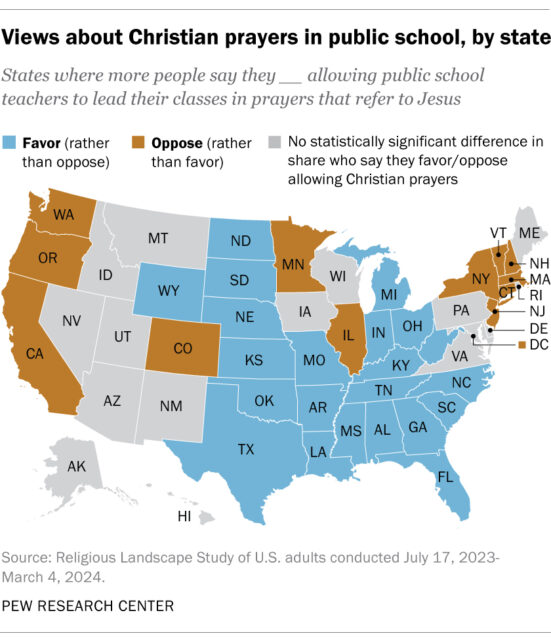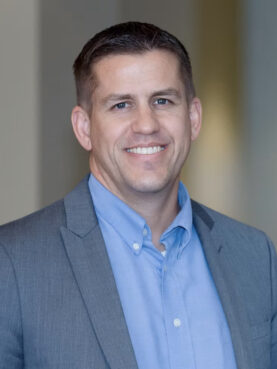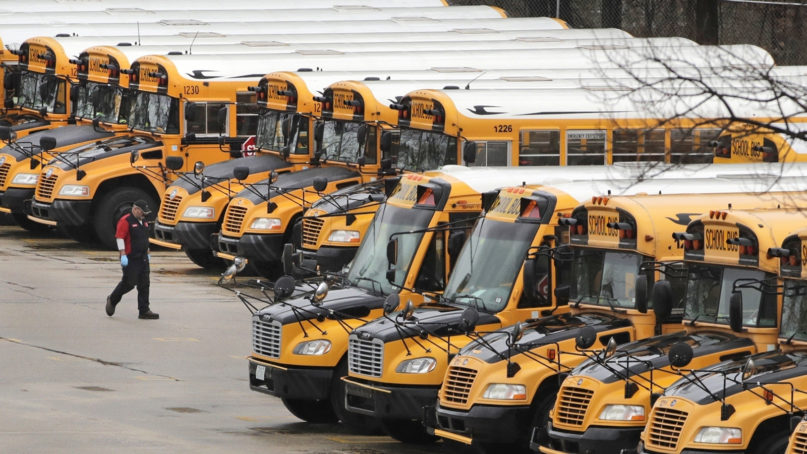
(RNS) — A new Texas law mandating that schools set a time for students to pray will likely be popular with many residents of the Lone Star State.
A new report from the Washington, D.C.-based Pew Research Center found that 61% of adults in Texas say they approve of allowing teachers to lead Christian prayers in the classroom. That makes Texas one of 22 states where at least half of the population approves of such prayers, and one of 14 states, mostly in the South, where 60% of the population agrees.
Majorities in 12 states oppose teacher-led prayer. In 16 states, the population is split.
Overall, 52% of Americans approve of Christian prayer in schools, according to a new analysis of data from the most recent Pew Religious Landscape Study, published earlier this year. Forty-six percent disapprove.
“Today, Americans are deeply split on the question of whether to allow Christian prayer in school,” the report says.

“Views about Christian prayers in public school, by state” (Graphic courtesy Pew Research Center)
That’s not stopping officials in states like Texas from pushing to allow more prayer in schools — although they are not mandating it be Christian.
On Saturday, Texas Governor Greg Abbott signed a law that requires schools to set aside time for students and staff to take part in voluntary prayer and Scripture reading. Under the law, school officials are required to “provide students and employees with an opportunity to participate in a period of prayer and reading of the Bible or other religious text on each school day.” The same law, however, also bars students and staff from participating unless they sign a consent form.
Abbott also signed a separate law requiring schools to display the Ten Commandments in classrooms. A federal appeals court recently ruled a similar law in Louisiana was unconstitutional.
Steven Collis, professor of law and director of the Bech-Loughlin First Amendment Center at the University of Texas at Austin, said the Texas law appears to have been written to avoid concerns about coerced prayers and other First Amendment restrictions. The law requires school districts to set up a time for prayer but bars students or school employees from participating unless they’ve signed a consent form, saying they understand the prayers would be voluntary. Any participant also must agree not to sue the school over prayer.
The bill also bans prayers over a public address system — as well as prayers or Bible readings where anyone who has not signed a consent form can hear them.
Collis said the law appears to be testing what kind of prayer at schools will be allowed, following a 2022 Supreme Court decision in favor of a former high school football coach who was fired after praying on the field after games.

Steven Collis. (Courtesy photo)
“I think it’s clear to me the legislature drafted this in a way to try to account for current case law,” said Collis.
Collis said the law still will likely face challenges in court. What happens, he said, if 95% of the students get consent to take part in prayer — will the remaining students feel pressure to do so as well? Or if teachers end up leading prayers?
The law professor said much will depend on how the new law is implemented.
“To me, it’s not an obvious establishment clause violation under current case law,” he said.
Collis said he’s wary about public polling on prayer in school — saying that while folks may approve of prayer, they also likely only approve of some prayers.
“Everything comes down to how you’re defining the phrase prayer in schools,” he said. “Nobody wants anyone else’s prayers forced upon them.”
Rocío Fierro-Pérez, political director of Texas Freedom Network, opposes the new law, calling it “unconstitutional and morally reprehensible.”
“No child should be pressured to perform piety to feel safe or accepted in a public school classroom,” Fierro-Pérez said in a statement after the bill was signed into law. “No teacher should have to referee prayer. And no family should have to fear that their beliefs will be marginalized by the institutions meant to educate their children.”
Pew’s data showed a wide range of views on school prayer by state. In Mississippi, for example, 81% of adults say they approved of Christian prayers in the classroom, followed by 75% in Alabama and Arkansas.

In this April 27, 2020, file photo, a worker passes public school buses parked at a depot in Manchester, New Hampshire. (AP Photo/Charles Krupa, File)
In D.C., by contrast, only 30% of adults approved of Christian prayers in the classroom, followed by 32% in Vermont and 34% in Oregon. States like Alaska, Iowa, Montana, Pennsylvania and Wisconsin are statistical ties, according to Pew data.
The Religious Landscape Study found earlier this year that the decline of Christianity in America appears to have slowed, though at 62% of the population, the number of American Christians remains considerably lower than two decades ago, when 78% identified as Christian in 2007. Today, 7% percent of Americans identify with a faith other than Christianity, and according to Pew, 29% do not identify with a religion.
As every state in the U.S. has seen religious decline, some states remain much more religious than others. For example, although 73% of adults in Alabama identified as Christian in Pew’s most recent study, only 45% of adults in Vermont say they are Christians. Overall, the gap between the 10 most religious states in the U.S. and the 10 least religious states is 21 percentage points.
Although the majority of Americans are still religious, more than a few are wary about the public role of religion — 44% of Americans said religion does more good than harm, according to the Religious Landscape report, with 19% saying it does more harm than good. And 35% say religion does equal amounts of harm and good.
Fewer than half of Americans say they pray everyday (44%), according to Pew, down from 58% in 2007.
